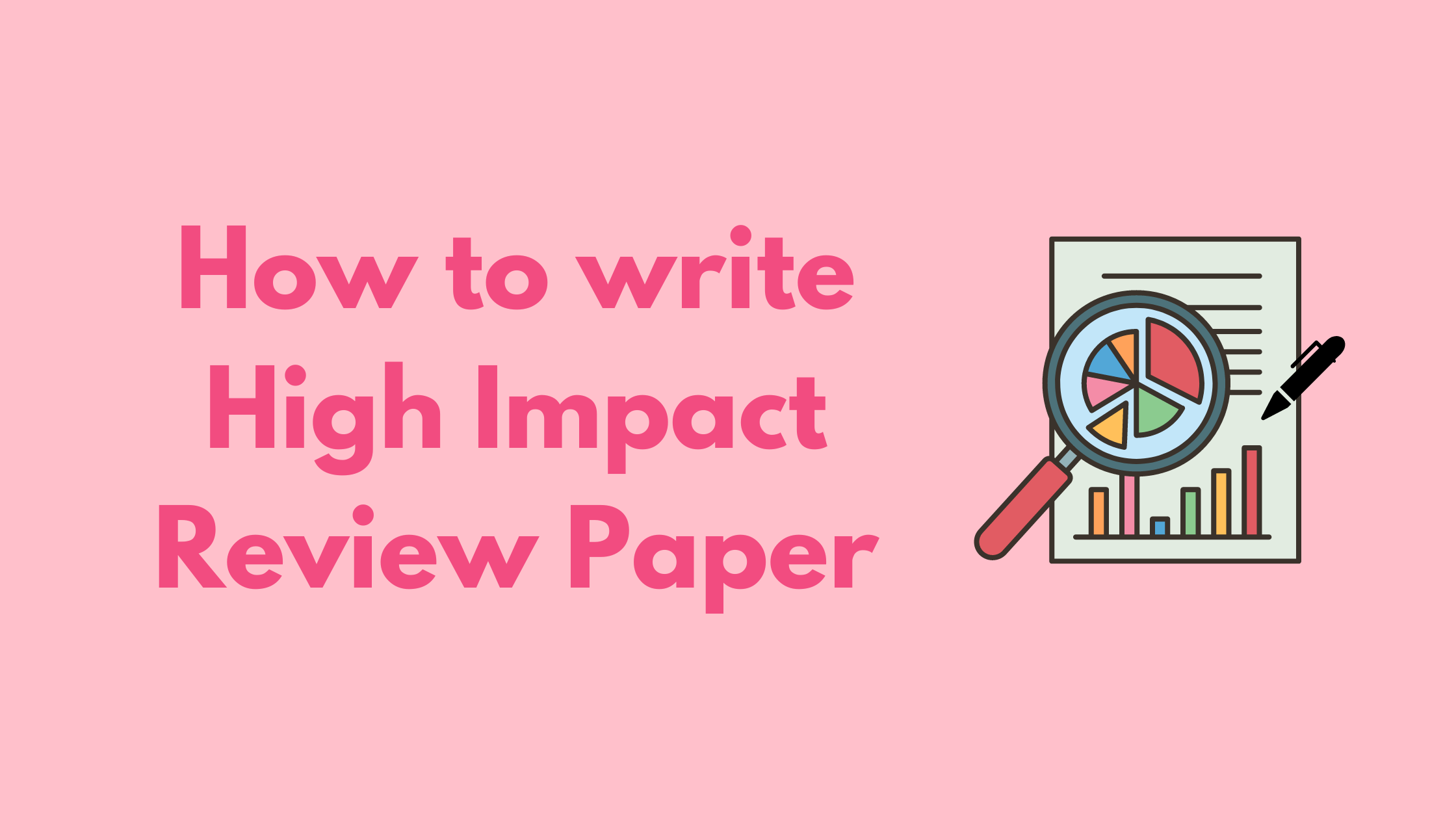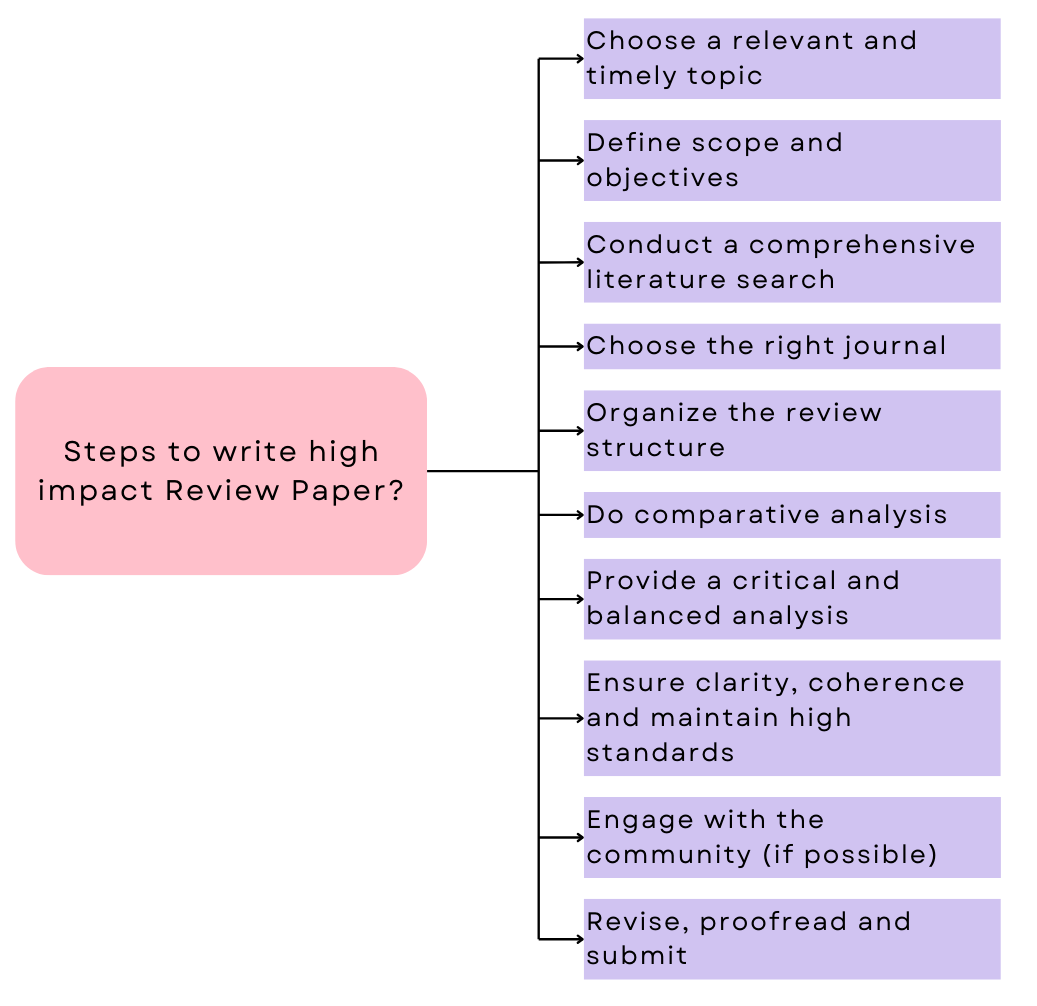How to write high impact Review Paper?
 Jyoti Maurya
Jyoti MauryaTable of contents
- STEPS
- Choose a relevant and timely topic
- Define scope and objectives
- Conduct a comprehensive literature search
- Choose the right journal
- Organize the review structure
- Do comparative analysis
- Provide a critical and balanced analysis
- Ensure clarity, coherence and maintain high standards
- Engage with the community (if possible)
- Revise, proofread and submit

Writing a high-impact review paper requires careful planning, thorough research, and clear writing. Following image shows the real-world practical steps to write a review paper which has high impact.

STEPS
Choose a relevant and timely topic
Relevance: Select a topic that is currently significant and has a broad interest within the field.
Timeliness: Ensure that the topic addresses recent advancements or emerging trends.
Gap Identification: Identify gaps in existing literature that your review can address
Define scope and objectives
Scope: Clearly define the boundaries of your review. Determine what will be included and excluded.
Objectives: Specify the main goals of the review, such as summarizing current knowledge, identifying gaps, and suggesting future research directions.
Conduct a comprehensive literature search
Databases: Use multiple databases (e.g., PubMed, IEEE Xplore, Google Scholar) to gather relevant literature.
Keywords: Develop a list of keywords and phrases related to your topic.
Inclusion/Exclusion Criteria: Establish criteria for selecting studies to ensure a comprehensive and unbiased review.
Choose the right journal
Journal Scope: Select a journal that aligns with the topic and scope of your review.
Impact Factor: Consider the journal’s impact factor and audience reach.
Submission Guidelines: Follow the journal’s submission guidelines meticulously.
Organize the review structure
Introduction: Introduce the topic, its significance, and the objectives of the review.
Methodology: Describe your literature search strategy, including databases, keywords, and selection criteria.
Main Body: Organize the content into coherent sections or themes. Common structures include chronological, thematic, methodological, or theoretical frameworks.
Discussion: Analyze and interpret the findings, highlight key insights, and discuss implications.
Conclusion: Summarize the main findings, restate their significance, and propose future research directions.
Do comparative analysis
Purpose: Compare and contrast the findings from different studies to identify trends, patterns, similarities, and differences.
Framework: Develop a framework for comparison, such as a table or matrix, to systematically evaluate the studies.
Key Metrics: Identify key metrics and criteria for comparison, such as accuracy, efficiency, scalability, and applicability.
Insights: Draw insights from the comparative analysis to highlight strengths, weaknesses, and areas for improvement in the existing research.
Provide a critical and balanced analysis
Summarize Key Findings: Present the main findings of the reviewed studies clearly and concisely.
Critically Evaluate: Assess the strengths and weaknesses of the studies, including methodologies, results, and interpretations.
Identify Trends and Gaps: Highlight emerging trends, inconsistencies, and areas that require further research.
Ensure clarity, coherence and maintain high standards
Clear Writing: Use clear and concise language. Avoid jargon and complex sentences.
Logical Flow: Ensure that the paper has a logical flow, with each section smoothly transitioning to the next.
Visual Aids: Use tables, figures, and diagrams to summarize information and enhance understanding.
Cite Sources: Accurately cite all sources using a consistent citation style.
Avoid Plagiarism: Ensure that all ideas and words are properly attributed.
Stay Objective: Maintain an unbiased tone and present a balanced view of the literature.
Engage with the community (if possible)
Collaborate with Experts: Consider collaborating with experienced researchers to enhance the quality of the review.
Seek Feedback: Share drafts with colleagues and mentors to receive constructive feedback.
Attend Conferences: Present preliminary findings at conferences to gather insights and improve your review.
Revise, proofread and submit
Multiple Drafts: Revise your paper multiple times to refine arguments and improve clarity.
Proofreading: Carefully proofread to eliminate grammatical errors and typos.
Consistency: Ensure consistency in terminology, citation style, and formatting
Submit: After carefully proofreading and getting enough feedback, just submit.
Writing a high-impact review paper is a valuable endeavor that can significantly contribute to the advancement of a scientific field. It synthesizes existing knowledge, highlights research gaps, guides future research, serves as an educational resource, establishes the author’s expertise, influences policy and practice, enhances citation metrics, and advances the field. It requires a systematic approach, from selecting a relevant topic to thorough literature search, critical analysis, clear writing, and engaging with the research community. By addressing these aspects, a well-crafted review paper can have a lasting impact on the scientific community and beyond.
Subscribe to my newsletter
Read articles from Jyoti Maurya directly inside your inbox. Subscribe to the newsletter, and don't miss out.
Written by

Jyoti Maurya
Jyoti Maurya
I create cross platform mobile apps with AI functionalities. Currently a PhD Scholar at Indira Gandhi Delhi Technical University for Women, Delhi. M.Tech in Artificial Intelligence (AI).